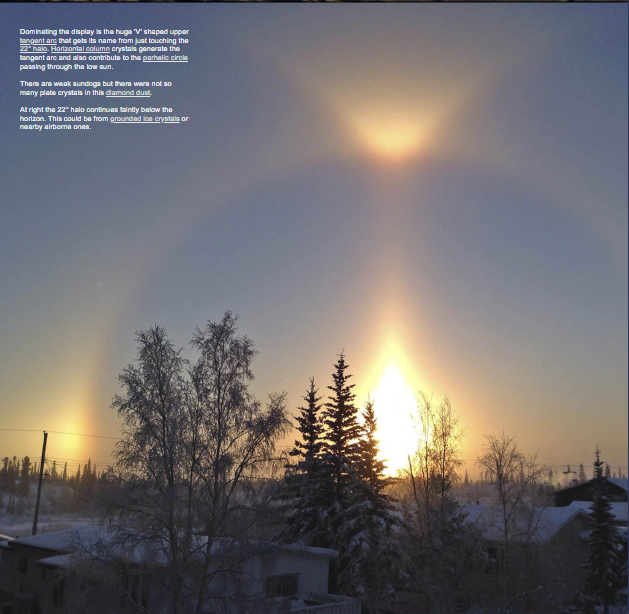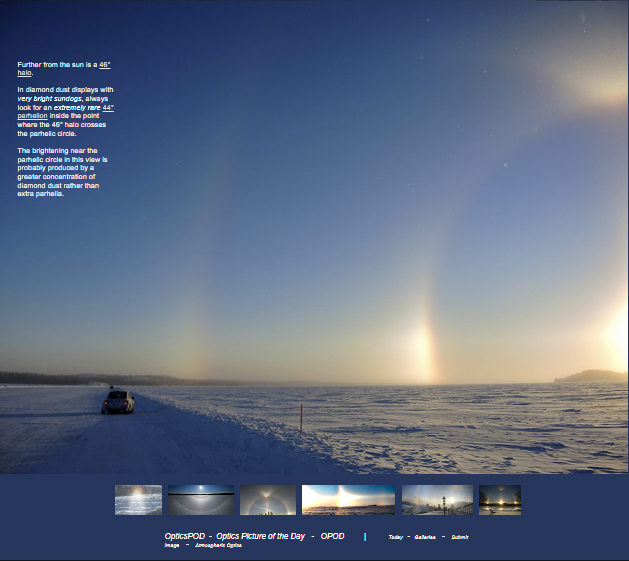Yellowknife Halos - OPOD
Yellowknife Halos - A Spectacular Atmospheric Phenomenon
Yellowknife, located in the Northwest Territories of Canada, is renowned for its stunning display of atmospheric optics known as Yellowknife Halos. These mesmerizing phenomena are caused by the interaction of sunlight with ice crystals suspended in the atmosphere. The unique combination of weather conditions and crystal structures in Yellowknife creates a spectacle that captivates both locals and visitors alike.
The Magnificent 'V' Shaped Upper Tangent Arc
One of the most prominent features of Yellowknife Halos is the colossal 'V' shaped upper tangent arc. This arc derives its name from its position, just touching the 22° halo. It is formed by horizontal column crystals, which not only generate the tangent arc but also contribute to the parhelic circle that passes through the low sun. The sheer size and grandeur of this arc make it a truly breathtaking sight.
The Enigmatic 22° Halo and Faint Extensions
In the Yellowknife Halos display, the 22° halo can be seen faintly extending below the horizon. This phenomenon can be attributed to either grounded ice crystals or nearby airborne ones. The 22° halo is a circular ring of light that forms at an angle of 22 degrees around the sun. Its appearance is caused by the refraction and reflection of sunlight within hexagonal ice crystals suspended in the atmosphere.
The Intriguing 46° Halo
Moving further away from the sun, another fascinating feature of Yellowknife Halos becomes visible - the 46° halo. Similar to the 22° halo, this circular ring of light forms at an angle of 46 degrees around the sun. It is created by the refraction and reflection of sunlight within hexagonal ice crystals. The 46° halo adds to the overall ethereal beauty of the Yellowknife Halos display.
The Elusive 44° Parhelion
In diamond dust displays with exceptionally bright sundogs, a rare and elusive phenomenon known as the 44° parhelion can sometimes be observed. This occurs within the point where the 46° halo intersects the parhelic circle. The 44° parhelion manifests as a brightening near the parhelic circle and is believed to be a result of a higher concentration of diamond dust rather than additional parhelia.
The Influence of Diamond Dust
Diamond dust, tiny ice crystals that resemble diamonds, plays a crucial role in shaping the Yellowknife Halos display. These microscopic crystals are responsible for creating the various optical phenomena observed in the atmosphere. The concentration and distribution of diamond dust determine the intensity and extent of the halos, sundogs, and other atmospheric features.
Weather Conditions and Crystal Structures
The occurrence of Yellowknife Halos is closely tied to specific weather conditions and crystal structures. The presence of diamond dust in the atmosphere is typically associated with cold temperatures and calm winds. These conditions allow for the formation and suspension of ice crystals in the air. The unique crystal structures, such as horizontally oriented column crystals, contribute to the distinct characteristics of the Yellowknife Halos display.
Observing Yellowknife Halos
To fully appreciate the beauty of Yellowknife Halos, it is essential to find a location with an unobstructed view of the sky. Clear, cold winter days provide ideal conditions for observing these atmospheric phenomena. Patience is key, as the intensity and visibility of the halos can vary throughout the day. Taking photographs can help capture the intricate details and preserve the memory of this captivating natural spectacle.
Conclusion
Yellowknife Halos are a testament to the awe-inspiring wonders of our atmosphere. The interplay between sunlight and ice crystals creates a mesmerizing display of halos, arcs, and circles that adorn the sky above Yellowknife. Whether you are a seasoned sky watcher or a casual observer, witnessing the Yellowknife Halos is an experience that will leave you in awe of the natural beauty that surrounds us. So, next time you find yourself in Yellowknife during the winter months, keep an eye on the sky and prepare to be enchanted by this extraordinary atmospheric phenomenon.

Yellowknife Halos
Diamond dust halos at Yellowknife, Northwest Territories, Canada pictured by Tom Andrews on an iPhone5. ©Tom Andrews, shown with permission

Dominating the display is the huge 'V' shaped upper tangent arc that gets its name from just touching the 22° halo. Horizontal column crystals generate the tangent arc and also contribute to the parhelic circle passing through the low sun.
There are weak sundogs but there were not so many plate crystals in this diamond dust.
At right the 22° halo continues faintly below the horizon. This could be from grounded ice crystals or nearby airborne ones.

Further from the sun is a 46° halo.
In diamond dust displays with very bright sundogs, always look for an extremely rare 44° parhelion inside the point where the 46° halo crosses the parhelic circle.
The brightening near the parhelic circle in this view is probably produced by a greater concentration of diamond dust rather than extra parhelia.
Note: this article has been automatically converted from the old site and may not appear as intended. You can find the original article here.
Reference Atmospheric Optics
If you use any of the definitions, information, or data presented on Atmospheric Optics, please copy the link or reference below to properly credit us as the reference source. Thank you!
-
<a href="https://atoptics.co.uk/blog/yellowknife-halos-opod/">Yellowknife Halos - OPOD</a>
-
"Yellowknife Halos - OPOD". Atmospheric Optics. Accessed on November 24, 2024. https://atoptics.co.uk/blog/yellowknife-halos-opod/.
-
"Yellowknife Halos - OPOD". Atmospheric Optics, https://atoptics.co.uk/blog/yellowknife-halos-opod/. Accessed 24 November, 2024
-
Yellowknife Halos - OPOD. Atmospheric Optics. Retrieved from https://atoptics.co.uk/blog/yellowknife-halos-opod/.